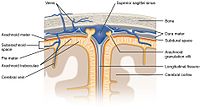
Photo from wikipedia
ABSTRACT Background The introduction of full-endoscopic lumbar discectomy (FELD) procedures has made it possible to challenge microscopic discectomy as the gold standard method to treat lumbar disc herniations. Purpose The… Click to show full abstract
ABSTRACT Background The introduction of full-endoscopic lumbar discectomy (FELD) procedures has made it possible to challenge microscopic discectomy as the gold standard method to treat lumbar disc herniations. Purpose The aim of the present study is to investigate the introductory-phase postoperative clinical improvement for FELD patients regarding leg pain, patient-reported outcome measurements (PROMs), complications, reoperations, and learning curve analysis. Methods All patients who underwent FELD at Sahlgrenska University Hospital, Sweden, were prospectively included during 2013– 2017. A total of 92 patients were enrolled and followed up for 1 year. The characteristics of the study population, degree of leg pain, complications, learning curve, and PROMs were retrieved from patient records and the National Quality Register for Spine Surgery (Swespine). Results The postoperative results demonstrated major improvements; leg pain measured by a numerical rating scale (0–10) decreased from 7.4 ± 2.25 to 2.76 ± 2.70, with a mean improvement of −4.54, (−3.62–5.46) 95% confidence interval (CI). The Oswestry Disability Index decreased by 30.48 (−36.27–23.73) with a 95% CI, and the EuroQol-5D increased by 0.39 (0.21–0.57) 95% CI. An assessment of the final surgical result showed that 91.6% ranked their general situation as better or much better. Specifically, regarding postoperative leg pain, 87% regarded their leg pain as completely gone, much better, or somewhat better, while 13% regarded their leg pain as unchanged or worse. A learning curve analysis showed that for every 10th FELD procedure performed; the duration of surgery decreased by 2 minutes. Conclusions In our study, the introduction of FELD as a safe, quick procedure for the treatment of lumbar disc herniations can yield significant gains in patient-reported outcome measurements and pain reduction. The rate of recurrence and complications is comparable to that of standard surgery.
Journal Title: International Journal of Spine Surgery
Year Published: 2020
Link to full text (if available)
Share on Social Media: Sign Up to like & get
recommendations!